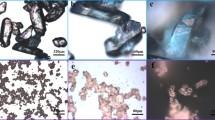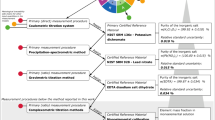Abstract
The rate of the electron exchange between thallium(I) and thallium(III) induced by iron(II) has been measured at various concentrations of Tl(I), Tl(III), and Fe(II).204Tl tracer, initially in the Tl(I) state, was used. Exchange induced by the separation method was less than 0.01%.
The mechanism earlier discussed is
which provides an exchange path in addition to the two-electron reaction*TlI+TlIII⇌*TlIII+TlI (kex). The rate law deduced from this mechanism agrees with experiment over a limited range of conditions but fails to account for the observed effect at low concentrations of Tl(I). The additional rate can be represented by inclusion of a term in which the rate of the induced exchange is independent of the concentration of Tl(I). When treated according to the resulting complete rate law the data are consistent with earlier photochemical studies. The present results in combination with other data give k2=3·106 M−1·sec−1 in 1M perchloric acid at 25°C. This is in satisfactory agreement with a recent pulse radiolysis measurement as well as with independent flash photolysis studies.
Similar content being viewed by others
References
B. WARNQVIST, R. W. DODSON, Inorg. Chem., 10 (1971) 2624.
K. G. ASHURST, W. C. E. HIGGINSON, J. Chem. Soc. (1953) 3044.
T. J. SWORSKI, J. Amer. Chem. Soc., 77 (1955) 4689.
T. J. SWORSKI, J. Amer. Chem. Soc., 79 (1957) 3655.
J. BEDNÁŘ, Coll. Czech. Chem. Commun., 24 (1959) 1240.
G. E. CHALLENGER, B. J. MASTERS, J. Amer. Chem. Soc., 78 (1956) 3012.
D. R. STRANKS, J. K. YANDELL, J. Phys. Chem., 73 (1969) 840.
B. CERCEK, M. EBERT, A. J. SWALLOW, J. Chem. Soc., (A) (1966) 612.
H. A. SCHWARZ, D. COMSTOCK, J. K. YANDELL, R. W. DODSON, J. Phys. Chem., 78 (1974) 488.
B. FALCINELLA, P. D. FELGATE, G. S. LAURENCE, J. Chem. Soc., Dalton, (1974) 1367 and (1975) 1.
G. BIEDERMANN, Arkiv Kemi, 5 (1953) 441.
L. K. CHUCHALIN, I. A. KUZIN, K. F. OBZHERINA, T. T. OMAROV, L. S. CHUCHALINA, Russ. J. Inorg. Chem., 12 (1967) 622.
S. W. GILKS, G. M. WAIND, Faraday Soc. Discussions, 29 (1960) 102.
D. R. STRANKS, J. K. YANDELL, Exchange Reactions, IAEA, Vienna, 1965, p. 83.
Author information
Authors and Affiliations
Additional information
Research performed under the auspices of the U.S. Energy Research and Development Agency.
Rights and permissions
About this article
Cite this article
Dodson, R.W. Thallium(II) in the chemically induced thallium(I)-Thallium(III) exchange. J. Radioanal. Chem. 30, 245–261 (1976). https://doi.org/10.1007/BF02516636
Issue Date:
DOI: https://doi.org/10.1007/BF02516636




